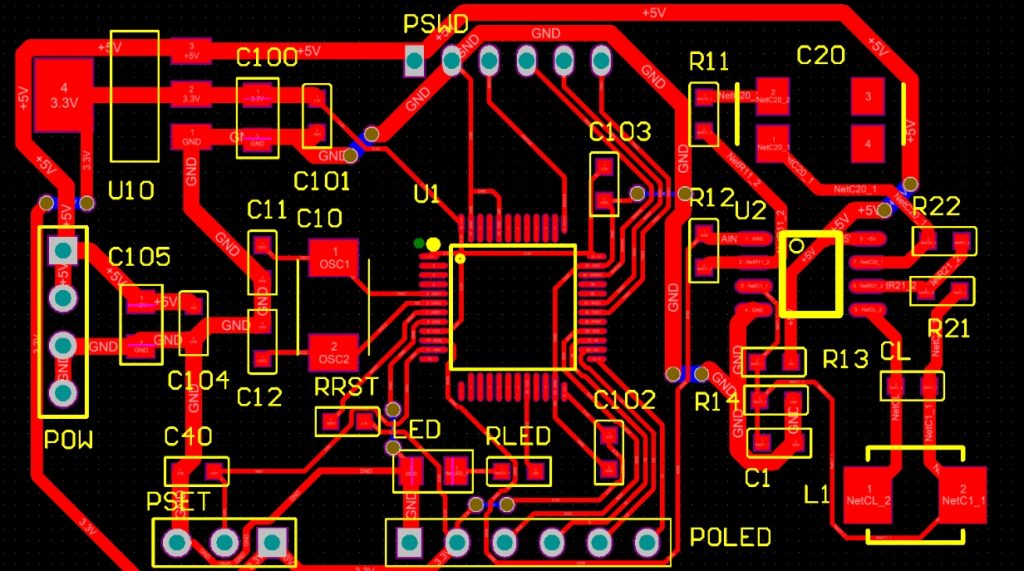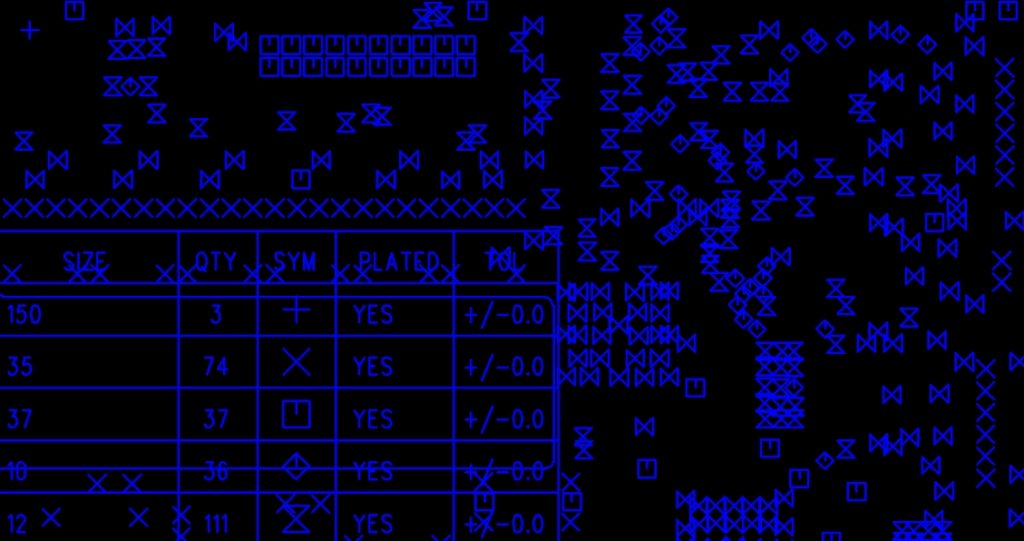Prior to PCB (Printed Circuit Board) prototyping, it is vital to prepare the necessary documentation, which is also an indispensable reference for the production process.
Table of Contents
The main documents required for PCB proofing
- Gerber file: Gerber file is one of the most commonly used file formats in PCB production. It contains information about all the layers of the board, such as the top copper layer, bottom copper layer, soldermask layer, silkscreen layer and so on. These files are usually generated by CAD (Computer Aided Design) software and saved in RS-274X standard format. Manufacturers can accurately understand the layout and details of the board through these files.
- Drill file (Excellon or NCDrill): This file contains information about the location and size of all the holes that need to be drilled on the board. The drill file is usually supplied with the Gerber file to ensure that the drill locations are precisely aligned with the circuit pattern.
- BOM (BillofMaterials) File: The BOM file lists all the materials and components that make up the board, including their quantities, specifications, and supplier information. This is very important for manufacturers because it helps them understand what materials and components they need and how to source them.
- Assembly drawings or assembly instructions: If your PCB needs to be assembled with other electronic components, then providing assembly drawings or assembly instructions is necessary. These documents detail how the components are to be mounted on the board, including component placement, orientation, and other necessary assembly instructions.
- Test Requirements or Test Instructions: If you need the manufacturer to perform specific tests, such as functional tests, electrical performance tests, etc., then providing Test Requirements or Test Instructions documents is necessary. These documents detail the test methods and standards to ensure that the boards produced meet your requirements.
- Design Rule Check File (DRC): The DRC file is used to verify that the PCB design meets manufacturing requirements and standards. It helps you to identify and correct potential problems at the design stage, thus avoiding errors during the manufacturing process.
- Design Files (e.g. CAD files): Although Gerber files are the primary files used in the manufacturing process, it is also helpful to provide the original CAD design files. These files can be used for subsequent design revisions or references, as well as shared when collaborating with other design teams.
Importance of Gerber files

Gerber Files for PCBs Gerber files are the most widely accepted design file format for manufacturing and assembling printed circuit boards (PCBs). They ensure an efficient manufacturing process by standardizing the transfer of design data between engineers and PCB manufacturers.
Once the circuit design is finalized and at the ordering stage, the contract manufacturer will require design files to accurately fabricate the PCB, and any errors in the supplied data will inevitably lead to board defects, additional costs and time delays. To avoid these consequences, Gerber files play a vital role in PCB manufacturing.
What is a Gerber file? What information does it contain?
Gerber files are a series of ASCII vector format files used to define PCB design specifications. They are generated using electronic design automation (EDA) or computer-aided design (CAD) tools and provide information such as board configuration parameters, aperture descriptions, XY coordinate positions and drawing instructions.
Configuration details include the size and shape of the PCB to be fabricated. Each layer of board information is recorded in separate files for defining components such as copper traces, pads, vias, soldermasks, silkscreens, logos, etc. The Gerber file indicates the XY coordinate location of each geometric shape, and instructions are used to draw these shapes on the solid board.
The basic components of a Gerber file include: board dimensions, shape, top assembly, top silkscreen, top soldermask, top paste, top copper, internal signals, inner layer, bottom copper, bottom paste, bottom soldermask, bottom silkscreen, bottom assembly, and fabrication information (to provide information on stacking, drilling details, cutting, etc.).
Generated by the computer-aided manufacturing (CAM) tools Gerber file extension can be self-selected by the user, usually use, such as “.TOP” on behalf of the top, “.BOT” on behalf of the bottom, “.drl” on behalf of the drilling data of the project naming method.
The Importance of Gerber Files in PCB Manufacturing
PCB designers are required to create Gerber files using EDA tools that are compatible with the PCB manufacturer’s system. Mismatches in formats or tool versions can cause delays in the manufacturing process.The primary goal of Gerber files is to deliver reliable PCB orders within the expected time frame. There are many benefits to using Gerber files in PCB manufacturing, including:
Gerber files provide intricately detailed designs that help PCB manufacturers build high-quality boards. Contract manufacturers can rely on these files to determine the accuracy of board dimensions, pad locations, alignment widths, and silkscreen legends. the accurate data provided by Gerber files can significantly reduce potential manufacturing errors.
They are compatible with a wide range of CAM tools used by PCB manufacturers, and Gerber files can be easily exported from most EDA tools, ensuring a smooth transition from design to the production phase of the PCB development cycle. In addition, the flexibility of the data format allows contract manufacturers to employ different manufacturing and assembly techniques to support advanced technologies.
The standardized format of Gerber files is critical to establishing a flawless PCB manufacturing process. These files are easy to read and easy to use for design engineers, layout specialists, and assembly line technicians to reduce confusion and minimize rework throughout the manufacturing process.
Typically, contract manufacturers use Gerber files to perform design for manufacturability (DFM) checks and evaluate production yields. Similarly, these files are used to create fixtures for board inspection and test, contributing to quality control of PCB production.
Gerber File Versions and Other Output Formats
The specification and complexity of the board determines the type and number of Gerber files generated. Different Gerber file formats have different data structures, but all are used to create templates for PCB fabrication.
RS274-D is the standard Gerber file format, which is a CNC format consisting of XY coordinates and plotting code with a “.gbr” extension, and was initially popular. However, the format required manual assignment of aperture codes to generate accurate Gerber files, so the Extended Gerber format was developed.
RS274-X is a revised version with a “.gbx” extension that uses ASCII format to combine the four main parts of Gerber information (configuration parameters, aperture maps, XY coordinates, and plotting commands) in a single file. In this format, the aperture position is automatically updated.
Gerber X2 is the latest version of the file and contains more data such as layer stacking details, perforation and pad properties, impedance control traces, etc. Supported extensions are “.top”, “.bot”, etc. This format is backward compatible with RS274-X, but contains a large amount of manufacturing data, dramatically reducing file errors and data ambiguity.
Open Database (ODB++) is another data exchange format that can contain all the information needed to define PCB layers in a single file, making it easy for designers to capture all the data needed for DFM inspection, such as board stackup, bill of materials, dimensions, and drilling details. It is supported by major CAM and DFM tools.
IPC-2581, the latest standard for PCB data organization and exchange from CAD to CAM systems during manufacturing and assembly, is an open standard for data transfer without human intervention. XML-based files are used to provide all manufacturing data to the CAM system, allowing direct extraction of design data without interpretation to the CAM system.
Gerber files are a commonly used data transfer format in the PCB manufacturing industry, supporting high volume mass production of PCB products.
In the process of PCB design and sampling, engineers will inevitably encounter a variety of technical problems, TopfastPCB has a professional technical support team, they have a wealth of experience in the industry and deep technical skills, to provide customers with a full range of technical support. Whether it is the review of design files, file format conversion, or sampling process problems, Topfast technical support team can quickly respond and provide effective solutions. This kind of professional technical support not only helps engineers to solve practical problems, but also improves their knowledge and understanding of PCB design and sampling, which provides a strong guarantee for the successful development of products.
